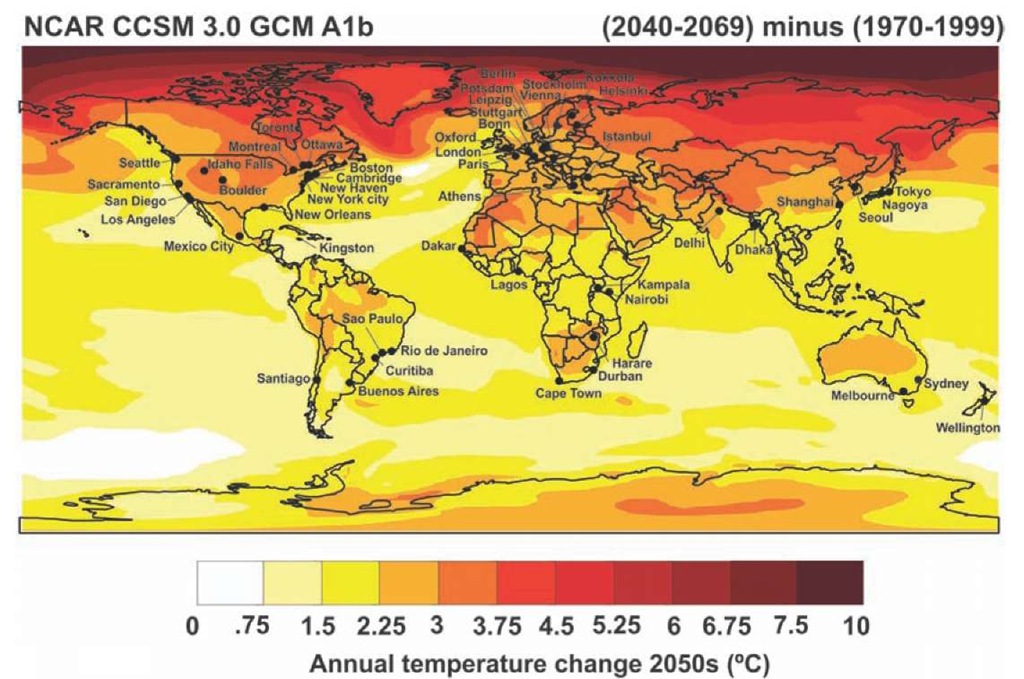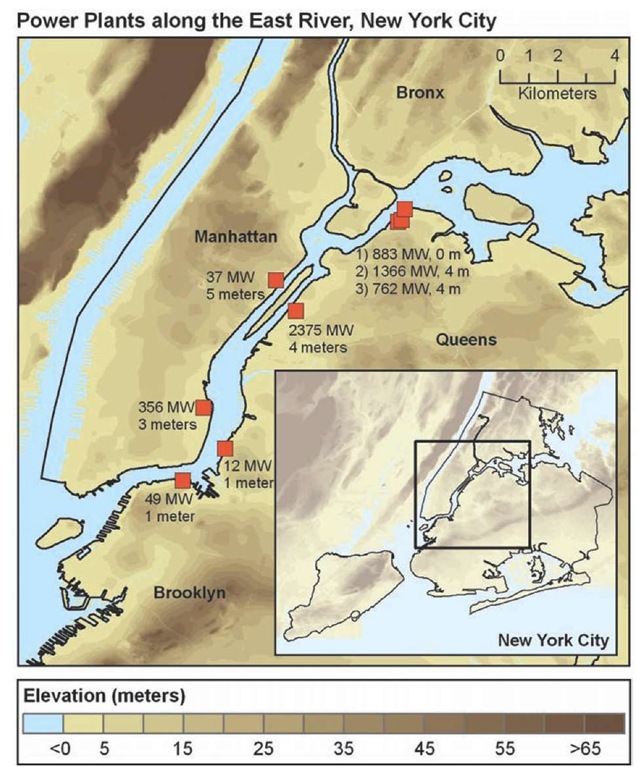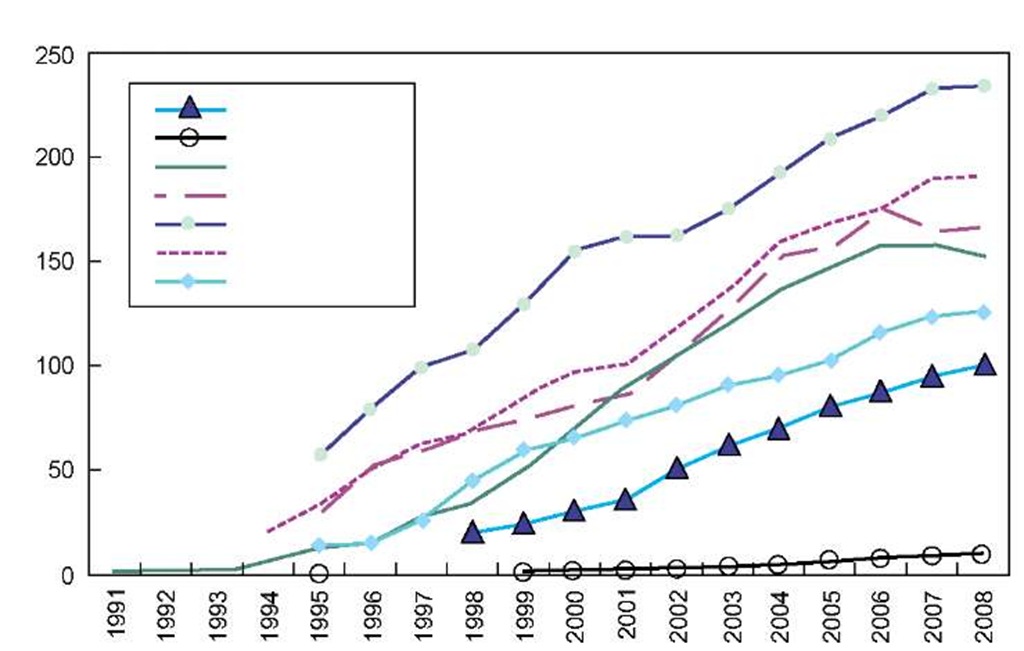Cities1 are home to over half of the world’s people and are at the forefront of the climate change issue. Climate change exerts added stress on urban areas through increased numbers of heat waves threatening the health of the elderly, the infirm, and the very young; more frequent and intense droughts and inland floods compromising water supplies; and for coastal cities, enhanced sea level rise and storm surges affecting inhabitants and essential infrastructure, property, and ecosystems. At the same time, cities are responsible for no less than 40% of global greenhouse gas emissions, and given current demographic trends, this level will likely only increase over time. These challenges highlight the need for cities to rethink how assets are deployed and people protected, how infrastructure investments are prioritized, and how climate will affect long-term growth and development plans.
Work on the First Assessment Report on Climate Change and Cities (ARC3) was launched by the Urban Climate Change Research Network (UCCRN) in November 2008 at a major workshop in New York City with the goal of building the scientific basis for city action on climate change. Eventually more than 100 lead and contributing authors from over 50 cities around the world contributed to the report, including experts from cities in both the developing and developed world, representing a wide range of disciplines. The topic focuses on how to use climate science and socio-economic research to map a city’s vulnerability to climate hazards, and how cities can enhance their adaptive and miti-gative capacity to deal with climate change over different timescales.
Defining the risk framework
A new vulnerability and risk management paradigm is emerging as a useful framework for city decision-makers to analyze how their city should seek to adapt to the anticipated impacts of climate change. The UCCRN climate change vulnerability and risk assessment framework (Figure 1) is composed of three sets of indicators:
• Climate hazards facing the city, such as more frequent and longer duration heat waves, greater incidence of heavy downpours, and increased and expanded coastal or riverine flooding;
• Vulnerabilities due to a city’s social, economic, or physical attributes such as its population size and density, topography, the percentage of its population in poverty, and the percentage of national GDP that it generates;
• Adaptive capacity aspects, factors that relate to the ability of a city to act, such as availability of climate change information, resources to apply to mitigation and adaptation efforts, and the presence of effective institutions, governance, and change agents.
In most cities, readily available data exist about climate hazards (trends and projections), population and geographic features, and institutional capacity that can serve as a foundation for adaptation planning efforts.
Figure 1: Urban climate change vulnerability and risk assessment framework.
In other cities that are still in the early stages of efforts to assess local vulnerabilities and climate risks, work can nonetheless begin by using generalized climate risks and information from similar urban areas as a starting point for local climate planning efforts.
For example, in Sorsogon City in the Philippines, the city government developed its local vulnerability assumptions using climate change projections and risk assessments from national government agencies and private research institutions.
Urban climate: processes, trends, and projections
Cities already face special climatic conditions that must be accounted for when preparing long-term climate change adaptation plans. These include:
• Urban heat island. Cities already tend to be hotter than surrounding suburban and rural areas due to the absorption of heat by concrete and other building materials and the removal of vegetation and loss of permeable surfaces, both of which provide evaporative cooling.
• Air pollution. The concentration of residential, commercial, industrial, electricity-generating, and transportation activities (including automobiles, railroads, etc.) contributes to air pollution, leading to acute and chronic health hazards for urban residents.
• Climate extremes. Major variability systems such as the El Nino-Southern Oscillation, the North Atlantic Oscillation, and oceanic cyclonic storms (e.g., hurricanes and typhoons) affect climate extremes in cities.
Figure 2: Cities represented in ARC3 and 2050s temperature projections for the NCAR CCSM 3.0 GCM with greenhouse gas emissions scenario A1b.
How these systems will interact with anthropogenic climate change is uncertain, but awareness of their effects can help urban areas to improve climate resilience.
Existing city-specific climate data and downscaled projections from global climate models can provide the scientific foundation for planning efforts by city decision-makers and other stakeholder groups (Figure 2). In twelve cities analyzed in depth in this report (Athens, Dakar, Delhi, Harare, Kingston, London, Melbourne, New York, Sao Paulo, Shanghai, Tokyo, and Toronto), average temperatures are projected to increase by between 1 °C and 4 °C by the 2050s. Most cities can expect more frequent, longer, and hotter heat waves than they have experienced in the past. Additionally, variations in precipitation are projected to cause more floods as the intensity of rainfall is expected to increase. In many cities, droughts are expected to become more frequent, more severe, and of longer duration.
Coastal cities should expect to experience more frequent and more damaging flooding related to storm events in the future due to sea level rise. In Buenos Aires, for example, damage to real estate from flooding is projected to total US$80 million per year by 2030, and US$300 million per year by 2050. This figure does not account for lost productivity by those displaced or injured by the flooding, meaning total economic losses could be significantly higher.
Sector-specific impacts, adaptation, and mitigation
Climate change is expected to have significant impacts on four sectors in most cities – the local energy system; water supply, demand, and wastewater treatment; transportation; and public health. It is critical that policymakers focus their attention on understanding the nature and scale of the impacts on each sector, developing adaptation and mitigation strategies, and determining policy alternatives.
Climate change and urban energy systems
Cities around the world have prioritized efforts to reduce energy consumption and the associated carbon emissions. This has been done both for localized efficiency reasons – to reduce the effects of high energy costs on household budgets, for example – as well as to respond to concerns that activities in cities are responsible for a large share of global greenhouse gas emissions. Emphasis is now being placed on urban energy system adaptation, as well, because climate change impacts such as the loss of key supply sources or transmission and distribution assets can jeopardize public health and the economic vitality of a city. For example, in New York City, power plants were historically sited on the waterfront to facilitate fuel supply delivery and to provide access to cooling waters. The majority of these facilities are at an elevation of less than 5m, making them susceptible to increased coastal flooding due to sea level rise (Figure 3).
Increases in the incidence or duration of summertime heat waves may result in higher rates of power system breakdown or failure, particularly if sustained high demand – driven by high rates of air conditioning use – stresses transmission and distribution assets beyond their rated design capacity. In Chinese cities, the number of households with air conditioners has increased dramatically in the past 15 years (Figure 4), although the extent to which usage is nearing a point where system vulnerabilities are heightened is still unclear. In cities heavily reliant on hydropower, changing precipitation patterns resulting from climate change may be problematic, if availability is reduced during summertime periods when demand is greatest.
Figure 3: Location and elevation of power plants along the East River in New York City.
Figure 4: Number of air conditioners per 100 households in selected Chinese cities.
For any given city, local analyses are necessary to determine the overall impact of climate change on energy demand, as it may increase or decrease depending on which of the seasonal effects of climate change (i.e., reduction in energy demand in cooler seasons and increased demand in warmer seasons) are most significant.
Cities can take robust steps to reduce their energy demand and thus their carbon emissions, and it is increasingly clear that many of these steps also provide significant adaptation benefits. These steps include:
• Develop demand management programs to cut peak load, reducing carbon emission levels and simultaneously lessening stress on the system during times of heightened vulnerability.
• Capitalize on the natural replacement cycle to update power plants and energy networks to reduce their carbon intensity and simultaneously increase their resilience to flooding, storm, and temperature-related risks.
Figure 5: Typical water-use cycle for cities and other developed supplies; dotted arrows indicate pathways that sometimes occur.
• Diversify local power supply sources to increase the share of renewables, thereby enhancing system resiliency and reducing carbon emissions.





